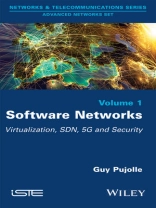Innehållsförteckning
Introduction ix
Chapter 1 Virtualization 1
1.1 Software networks 5
1.2 Hypervisors 7
1.3 Virtual devices 11
1.4 Conclusion 12
Chapter 2 Sdn (software-defined Networking) 15
2.1.The objective 16
2.2 The ONF architecture 19
2.3 NFV (Network Functions Virtualization) 25
2.4 OPNFV 27
2.5 Southbound interface 28
2.6 The controller 29
2.7 Northbound interface 31
2.8 Application layer 32
2.9 Urbanization 33
2.10 The NSX architecture 36
2.11 CISCO ACI (Application Centric Infrastructure) 40
2.12 Open Contrail and Juniper 42
2.13 Brocade 43
2.14 Alcatel Lucent’s SDN architecture 44
2.15 Conclusion 45
Chapter 3 Smart Edges 49
3.1 Placement of the controller 49
3.2 Virtual access points 55
3.3 Software LANs 58
3.4 Automation of the implementation of software networks 60
3.5 Intelligence in networks 61
3.6 Management of a complex environment 62
3.7 Multi-agent systems 65
3.8 Reactive agent systems 70
3.9 Active networks 72
3.10 Programmable networks 74
3.11 Autonomous networks 74
3.12 Autonomic networks 75
3.13 Situated view 77
3.14 Conclusion 79
Chapter 4 New-generation Protocols 81
4.1 Open Flow 83
4.2 VXLAN 90
4.3 NVGRE (Network Virtualization using Generic Routing Encapsulation) 91
4.4 MEF Ethernet 92
4.5 Carrier-Grade Ethernet 93
4.6 TRILL (Transparent Interconnection of a Lot of Links) 97
4.7 LISP (Locator/Identifier Separation Protocols) 99
4.8 Conclusion 100
Chapter 5. Mobile Cloud Networking and Mobility Control 103
5.1 Mobile Cloud Networking 103
5.2 Mobile Clouds 108
5.3 Mobility control 110
5.4 Mobility protocols 115
5.5 Mobility control 116
5.5.1 IP Mobile 116
5.5.2 Solutions for micromobility 117
5.6 Multihoming 119
5.7 Network-level multihoming 121
5.7.1 HIP (Host Identity Protocol) 122
5.7.2 SHIM6 (Level 3 Multihoming Shim Protocol for IPv6) 124
5.7.3 m Co A (Multiple Care-of-Addresses) in Mobile IPv6 125
5.8 Transport-level multihoming 127
5.8.1 SCTP (Stream Control Transmission Protocol) 127
5.8.2 CMT (Concurrent Multipath Transfer) 132
5.8.3 MPTCP (Multipath TCP) 135
5.9 Conclusion 135
Chapter 6 Wi-fi and 5g 137
6.1 3GPP and IEEE 138
6.2 New-generation Wi-Fi 139
6.3 IEEE 802.11ac 140
6.4 IEEE 802.11ad 142
6.5 IEEE 802.11af 143
6.6 IEEE 802.11ah 145
6.7 Small cells 147
6.8 Femtocells 148
6.9 Hotspots 151
6.10 Microcells 153
6.11 Wi-Fi Passpoint 153
6.12 Backhaul networks 158
6.13 Software radio and radio virtual machine 160
6.14 5G 162
6.15 C-RAN 168
6.16 The Internet of Things 171
6.17 Sensor networks 172
6.18 RFID 174
6.19 EPCglobal 177
6.20 Security of RFID 178
6.21 Mifare 179
6.22 NFC (Near-Field Comunication) 180
6.23 Mobile keys 181
6.24 NFC contactless payment 182
6.25 HIP (Host Identity Protocol) 184
6.26 The Internet of Things in the medical domain 184
6.27 The Internet of Things in the home 186
6.28 Conclusion 187
Chapter 7 Security 189
7.1 Secure element 191
7.2 Virtual secure elements 195
7.3 The TEE (Trusted Execution Environment) 197
7.4 TSM 199
7.5 Solution without a TSM 203
7.6 HCE 204
7.7 Securing solutions 205
7.8 Conclusion 212
Chapter 8. Concretization and Morphware Networks 213
8.1 Accelerators 214
8.2 A reconfigurable microprocessor 215
8.3 Morphware networks 220
8.4 Conclusion 223
Conclusion 225
Bibliography 229
Index 231












